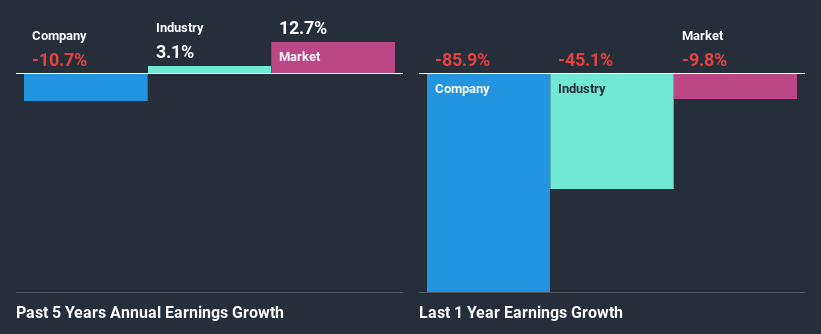- India
- /
- Auto Components
- /
- NSEI:JAYBARMARU
Jay Bharat Maruti Limited's (NSE:JAYBARMARU) Has Performed Well But Fundamentals Look Varied: Is There A Clear Direction For The Stock?

Jay Bharat Maruti's (NSE:JAYBARMARU) stock up by 3.1% over the past month. However, we decided to study the company's mixed-bag of fundamentals to assess what this could mean for future share prices, as stock prices tend to be aligned with a company's long-term financial performance. Specifically, we decided to study Jay Bharat Maruti's ROE in this article.
Return on equity or ROE is a key measure used to assess how efficiently a company's management is utilizing the company's capital. Put another way, it reveals the company's success at turning shareholder investments into profits.
See our latest analysis for Jay Bharat Maruti
How Do You Calculate Return On Equity?
ROE can be calculated by using the formula:
Return on Equity = Net Profit (from continuing operations) ÷ Shareholders' Equity
So, based on the above formula, the ROE for Jay Bharat Maruti is:
1.2% = ₹48m ÷ ₹4.1b (Based on the trailing twelve months to September 2020).
The 'return' is the profit over the last twelve months. One way to conceptualize this is that for each ₹1 of shareholders' capital it has, the company made ₹0.01 in profit.
What Has ROE Got To Do With Earnings Growth?
We have already established that ROE serves as an efficient profit-generating gauge for a company's future earnings. Depending on how much of these profits the company reinvests or "retains", and how effectively it does so, we are then able to assess a company’s earnings growth potential. Assuming everything else remains unchanged, the higher the ROE and profit retention, the higher the growth rate of a company compared to companies that don't necessarily bear these characteristics.
Jay Bharat Maruti's Earnings Growth And 1.2% ROE
As you can see, Jay Bharat Maruti's ROE looks pretty weak. Even compared to the average industry ROE of 5.6%, the company's ROE is quite dismal. Given the circumstances, the significant decline in net income by 11% seen by Jay Bharat Maruti over the last five years is not surprising. We reckon that there could also be other factors at play here. For example, the business has allocated capital poorly, or that the company has a very high payout ratio.
However, when we compared Jay Bharat Maruti's growth with the industry we found that while the company's earnings have been shrinking, the industry has seen an earnings growth of 3.1% in the same period. This is quite worrisome.

Earnings growth is a huge factor in stock valuation. What investors need to determine next is if the expected earnings growth, or the lack of it, is already built into the share price. Doing so will help them establish if the stock's future looks promising or ominous. One good indicator of expected earnings growth is the P/E ratio which determines the price the market is willing to pay for a stock based on its earnings prospects. So, you may want to check if Jay Bharat Maruti is trading on a high P/E or a low P/E, relative to its industry.
Is Jay Bharat Maruti Making Efficient Use Of Its Profits?
When we piece together Jay Bharat Maruti's low three-year median payout ratio of 10.0% (where it is retaining 90% of its profits), calculated for the last three-year period, we are puzzled by the lack of growth. The low payout should mean that the company is retaining most of its earnings and consequently, should see some growth. It looks like there might be some other reasons to explain the lack in that respect. For example, the business could be in decline.
Moreover, Jay Bharat Maruti has been paying dividends for at least ten years or more suggesting that management must have perceived that the shareholders prefer dividends over earnings growth.
Conclusion
Overall, we have mixed feelings about Jay Bharat Maruti. Even though it appears to be retaining most of its profits, given the low ROE, investors may not be benefitting from all that reinvestment after all. The low earnings growth suggests our theory correct. Wrapping up, we would proceed with caution with this company and one way of doing that would be to look at the risk profile of the business. To know the 5 risks we have identified for Jay Bharat Maruti visit our risks dashboard for free.
If you’re looking to trade Jay Bharat Maruti, open an account with the lowest-cost* platform trusted by professionals, Interactive Brokers. Their clients from over 200 countries and territories trade stocks, options, futures, forex, bonds and funds worldwide from a single integrated account. Promoted
New: Manage All Your Stock Portfolios in One Place
We've created the ultimate portfolio companion for stock investors, and it's free.
• Connect an unlimited number of Portfolios and see your total in one currency
• Be alerted to new Warning Signs or Risks via email or mobile
• Track the Fair Value of your stocks
This article by Simply Wall St is general in nature. It does not constitute a recommendation to buy or sell any stock, and does not take account of your objectives, or your financial situation. We aim to bring you long-term focused analysis driven by fundamental data. Note that our analysis may not factor in the latest price-sensitive company announcements or qualitative material. Simply Wall St has no position in any stocks mentioned.
*Interactive Brokers Rated Lowest Cost Broker by StockBrokers.com Annual Online Review 2020
Have feedback on this article? Concerned about the content? Get in touch with us directly. Alternatively, email editorial-team@simplywallst.com.
About NSEI:JAYBARMARU
Jay Bharat Maruti
Manufactures and sells auto components and assembly systems in India.
Slight second-rate dividend payer.
Similar Companies
Market Insights
Community Narratives




